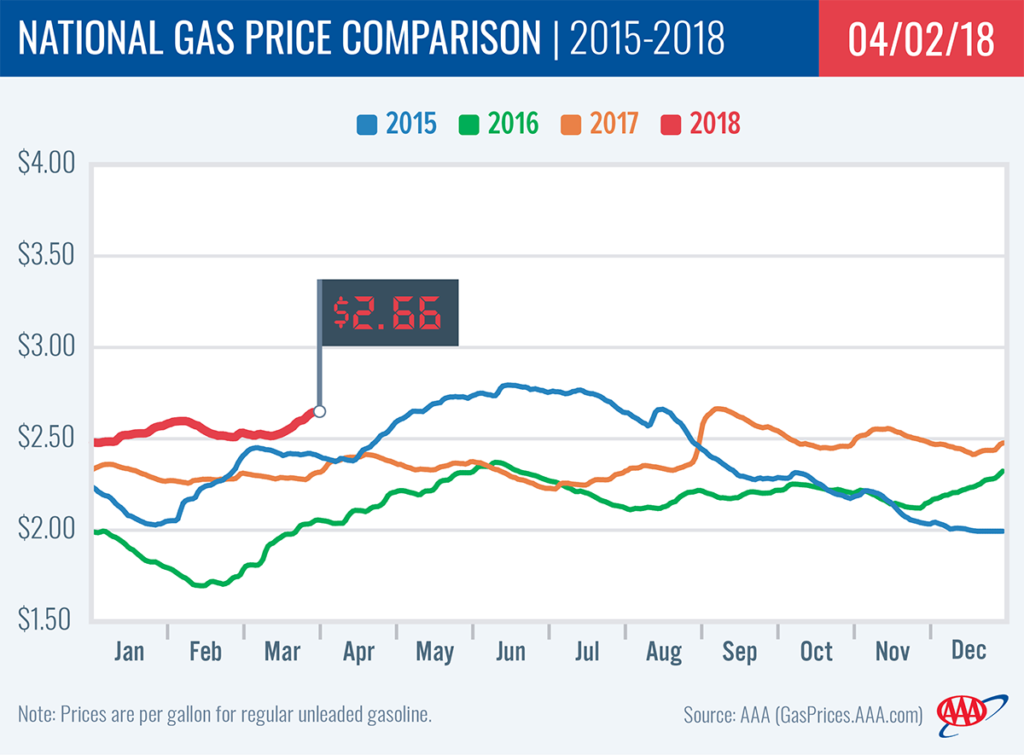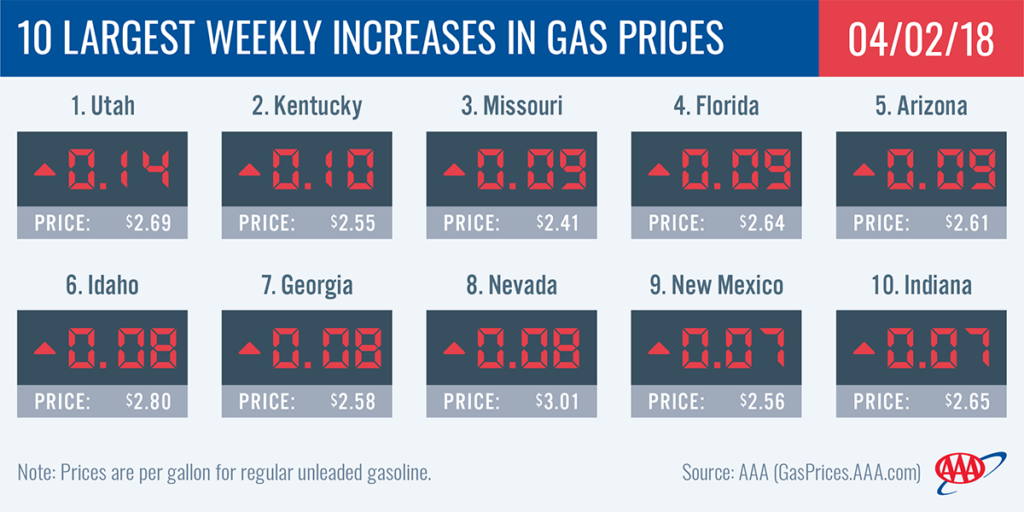Gas prices are edging up across the country as the market continues to purge winter-blend gasoline to make room for summer storage. At $2.66, the national gas price average is 5-cents more expensive on the week and 11-cents more expensive than two weeks ago.
“Today, only 38 percent of U.S. gas stations are selling gasoline for $2.50 or less and that percentage will likely dwindle in coming weeks,” said Jeanette Casselano, AAA spokesperson. “The holiday weekend, strong demand and preparation for summer gasoline are all factors that have driven and will continue to drive higher gas prices into early spring.”
In spite of price fluctuations, gasoline demand fell to 9.2 b/d according to the latest Energy Information Administration data – the lowest point for the month of March, but remains strong for this time of year.
Quick Stats
- The nation’s top 10 largest weekly increases are: Utah (+14 cents), Kentucky (+10 cents), Missouri (+9 cents), Florida (+9 cents), Arizona (+9 cents), Idaho (+8 cents), Georgia (+8 cents), Nevada (+8 cents), New Mexico (+7 cents) and Indiana (+7 cents).
- The nation’s top 10 most expensive markets are: Hawaii ($3.52), California ($3.51), Washington ($3.17), Alaska ($3.13), Oregon ($3.09), Nevada ($3.01), Pennsylvania ($2.86), Washington, DC ($2.83), Idaho ($2.80) and New York ($2.77).
West Coast
Drivers in West Coast states are paying the highest pump prices in the nation: Hawaii ($3.52), California ($3.51), Washington ($3.17), Alaska ($3.13), Oregon ($3.09) and Nevada ($3.01). On the week, all drivers in these states saw an increase in prices at the pump. Arizona (+9 cents) saw the largest leap, while Hawaii (+1 cent) saw the smallest.
At 1.59 million b/d, last week’s total gasoline production rate is nearly 60,000 b/d less than the rate last year at this time. According to the EIA’s latest weekly report, total gasoline inventories in the region declined by 36,000 b/d last week to sit at 32.7 million bbl.. However, inventories may decline further with this week’s scheduled planned maintenance at the Phillips 66 Los Angeles Refinery, which can produce up to 147,000 b/d of gasoline.
Great Lakes and Central
Gas prices are more expensive on the week across the Great Lakes and Central region with three states landing on this week top 10 list with the biggest increases: Kentucky (+10 cents), Missouri (+9 cents) and Indiana (+7 cents). Nebraska ($2.56) was the only state in the region to see no change at the pump this week.
Kentucky (+37 cents) and Indiana (+35 cents) are the leading states in the region with the largest year-over-year increase. Ohio (+17 cents) has the region’s and country’s lowest year-over-year difference in gas prices.
With a nearly 500,000 bbl draw, gasoline inventories continue to sit above the 58 million bbl mark. The region carries the second-highest inventory level in the country – second to the South and Southeast’s 84 million bbl.
South and Southeast
At nearly a dime increase, Florida (+9 cents) has the fourth largest gas price jump in the country and the highest in the South and Southeast on the week. Georgia (+8 cent) and New Mexico (+7 cents) also saw large jumps. Despite the increases, the South and Southeast continue to carry the least expensive gas prices averages in the country: Arkansas ($2.38), Mississippi ($2.40), Oklahoma ($2.42), Alabama ($2.43), Texas ($2.43) Louisiana ($2.44) and South Carolina ($2.44).
Motorists in South Carolina are paying 40-cents more for a gallon of gas compared to the beginning of April 2017. This is the third highest year-over-year increase of any state in the country. Georgia (+38 cents) has the fifth highest increase compared to this time last year.
The region was the only one to see a jump in gasoline inventories. With an addition of 418,000 bbl, inventories total above 84 million bbl, according to the EIA.
Mid-Atlantic and Northeast
Pump prices are up as much as 7 cents across the Mid-Atlantic and Northeast region on the week. Pennsylvania (+7 cents) and Maine (+6 cents) saw the largest increases. Pennsylvania ($2.86) and Washington, D.C. ($2.83) carry the most expensive prices while Virginia ($2.47) and Tennessee ($2.46) sell the least expensive.
Compared to one year ago, Tennessee (+39 cents), Maine (+38 cents), New Jersey (+37 cents) and Massachusetts (+36 cents) motorists are paying significantly more to fill up at the pump.
With a 3.3 million bbl draw, the Mid-Atlantic and Northeast region saw the largest drop in inventory on the week, according to EIA data. At 56 million bbl in total, inventories sit 10 million bbl below this time last year.
Rockies
Utah (+14 cents) and Idaho (+8 cents) land on this week’s top 10 states with the largest increase on the week. At $2.80, Idaho’s gas price average is the ninth most expensive in the country and the most expensive in the Rockies region. Eleven cents cheaper, Utah ($2.69) has the second highest gas price average in the region. On the week, pump prices jumped 4-cents in Colorado, three cents in Wyoming and remained stabled in Montana ($2.58).
Utah (+24 cents) and Idaho (+23 cents) also rank as two of the three leading states in the country with gas prices nearly a quarter more than this time last month.
The EIA reports that gasoline inventories in this region were unchanged on the week, remaining at 8 million bbl.
Oil market dynamics
The NYMEX was closed on Friday due to the holiday. On Thursday, WTI increased 56 cents to settle at $64.94. The increase was led by Baker Hughes active rig count report that revealed the U.S. dropped seven active rigs last week, bringing the total to 797. Price gains were tempered by EIA’s weekly report showing that total crude oil inventories grew by 1.5 million bbl last week. Moreover, domestic crude hit another top record for weekly production at 10.4 million b/d. If this week’s EIA report shows another inventory build, driven by record-setting oil production, prices may move lower as it may signal that global crude supplies may be on the rise again.
Motorists can find current gas prices along their route with the free AAA Mobile app for iPhone, iPad and Android. The app can also be used to map a route, find discounts, book a hotel and access AAA roadside assistance. Learn more at AAA.com/mobile.



